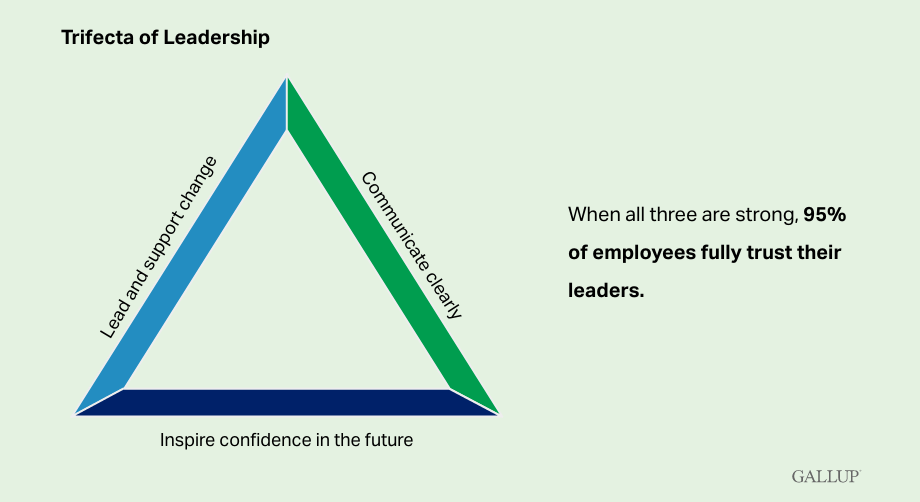Story Highlights
- Employee trust in leadership has declined, as has employee engagement
- Clear communication from leaders helps set expectations and priorities
- Manager development is key to communicating and navigating change
The red lights are flashing on America’s business leadership dashboard. Leaders are losing trust with their employees.
Three key leadership measures tracking behaviors that drive alignment and execution for organizations have declined since the start of the pandemic. Most notable is a drop in trust in leadership. Only 21% of U.S. employees strongly agree that they trust the leadership of their organization. This marks a noteworthy decline from its 2019 peak (24%) and raises a serious question about morale in American businesses.
Trust begins to build when employees feel inspired by senior leaders and see strategic actions leading to business success. As such, the declines in employees’ confidence in the financial future of their organization and feeling inspired by their leadership further indicate that employees’ trust in leadership is evaporating. And all of this coincides with a historic decline in employee engagement.

Building trust in leadership is necessary to drive the performance that companies seek. When change is clearly defined and successfully managed, performance goals are met, and a strong, positive corporate culture is in place, trust follows. These are not simple outcomes to accomplish, nor are they quick and easy fixes. But they lead people to begin to build trust with leaders.
Gallup finds that when employees strongly agree that their leaders implement three specific actions, 95% fully trust their leaders.
Here’s what the best leaders do to earn (or build) trust:
1. Trusted Leaders Communicate Clearly
In 2020, at the start of the pandemic, employee engagement in the U.S. reached a record high. This coincided with a radical new way of seeing our leaders and hearing their thoughts. We saw executives on video town halls, in their homes, wearing baseball caps, with kids or barking dogs in the background. The suit and tie were gone. The perfectly polished speech was gone. And leaders were honest about what they didn’t know. They became vulnerable: They were open about admitting they didn’t have answers yet. And they were actively listening to their front-line and essential workers. They said, “Tell me what’s going on and what you need to do your job.”
In the early stages of the pandemic, an astonishing 55% of employees strongly agreed that their leaders communicated a clear plan of action in response to COVID-19. By the middle of 2022, only 22% strongly agreed that their leaders communicated a clear plan of action for how they would move forward post-pandemic. Clearly, communication had lessened -- and it was affecting employees’ understanding of the envisioned future state of their workplace.
Notably, the percentage of employees saying they know what’s expected of them at work dropped to a record low in 2022. Great leaders provide a clear vision for their people. They explain where the company is coming from and where it’s going. They also explain what the company will always do (setting clear expectations and creating stability for the organization) and what it needs to do now (establishing priorities to help employees move forward). When leaders clearly articulate their vision and the approach needed to achieve it, they offer their employees a road map for where to focus their energy.
Many leaders have been eager to get back to the office and back to business as usual. But there is no longer “usual business.” The best leaders have taken a lesson from the pandemic playbook. Instead of going back to pre-2020 communication methods, they’ve given thought to what they learned during lockdowns. They have identified the best ways to communicate with their employees and kept to those rhythms. They understand that communication is at the heart of leadership. Even though the crisis is over, they’ve found that increased two-way communication pays off in higher productivity and performance.
When leaders clearly articulate their vision and the approach needed to achieve it, they offer their employees a road map for where to focus their energy.
2. Trusted Leaders Inspire Confidence in the Future
At the beginning of the pandemic, leaders didn’t know what was up ahead -- but that didn’t stop employees from trusting them. Leaders proved that they were aware of the challenges and risks, and they approached those challenges thoughtfully, with company values (and empathy) in mind.
Leading change is much harder when your team can’t make sense of it. Only 18% of employees strongly agree that their leaders help them see how changes made today will affect their organization. And just two in 10 feel highly confident in their leaders to manage emerging challenges.
Followers don’t need the entire plan in detail. They need a broad sense of the primary goal and the next steps to get there. By giving information in digestible chunks, leaders communicate that they have a plan and know how to get there. They also highlight big (and small) successes or progress along the way. This reminds employees that the plan is working and helps build confidence in their strategic direction.
Some leaders get one of these things right, but not others. They provide the big picture but miss the practical next steps or acknowledgment of progress. Or they focus on the next steps without giving their teams the main objective. But projecting trustworthy leadership means communicating all of it: I know where we’re going; here is what we need to do to get us there, and here is where we are making progress.
3. Trusted Leaders Lead and Support Change
When employees don’t trust leadership, the breakdown is often at the manager level. To successfully navigate change, leaders need to make every effort to provide their managers with training and development. When the pandemic presented them with a disrupted work environment, for example, 57% of hybrid managers indicated they were left out in the cold without training to help them work in this new way.
So, as leaders seek to build trust, they must first give their managers the tools to communicate: Articulate the vision, explain the why, answer questions, and help their people believe in the change.
This intentional communication will build trust and confidence throughout the organization. When managers actively support change, employees are 11 times as likely to believe their leaders provide a clear vision of how today’s changes will affect their organization.
Gallup has established seven guiding principles of change management that should be applied when leaders plan their communication with managers. These principles help managers to become ambassadors of change and drive that change within their own teams.
- Clearly articulate the vision for change.
- Involve the right people: limited vs. broad involvement.
- Communicate the right information at the right time.
- Always account for resistance to change.
- Celebrate short-term wins without declaring premature victory.
- Effectively anchor the change to the organization.
- Always plan for change to be “the only constant.”
One simple action is for leaders to have regular manager-only meetings to understand the questions they are hearing and help them provide answers for their teams. Here’s what needs to happen. Let’s talk about what this means for your teams, processes and routines.
Next, leaders must set the expectation that every manager discusses with their team how change will impact them. Only about three in 10 leaders and managers say they have discussed with each team member how changes in their organization will affect them specifically. As mentioned above, this requires more than one-way communication. It’s a two-way conversation that makes employees believe in their leadership, and that happens at the team level with the manager.
Trust Starts by Listening Today
All leaders can agree that business runs on communication. But it’s those invaluable two-way conversations, especially during times of disruption, that are essential to building confidence and trust. When employees strongly agree that they have had opportunities to provide honest feedback about organizational changes, they are 7.4 times as likely to have confidence in their leaders to successfully manage emerging challenges.
Many leaders have had to implement major organizational changes -- from hybrid work policies to new strategic initiatives -- and they’ve missed a big opportunity to build trust by not including their teams in the process.
This should be a wake-up call to leaders and an invitation to pursue more successful change efforts in the future. We know that trust in leadership impacts engagement, performance, retention and much more. And that trust begins with having effective and supportive two-way conversations with followers, not with having all the answers.
Clearly, the pandemic put trust to the test for a lot of companies. And many leaders likely feel this ebbing of connection, of bonding, within their organization. It can be a little scary! But the good news is that employee trust can be regained. When leaders communicate clearly, inspire confidence in the future and support their people during times of change, they build the trust necessary to reach higher levels of productivity and performance.
Begin rebuilding employee trust today.
- Track U.S. employees’ perceptions of their interactions with leaders and managers.
- Learn how to become a more effective leader.
- Lead better by using your strengths with CliftonStrengths for Leaders.




